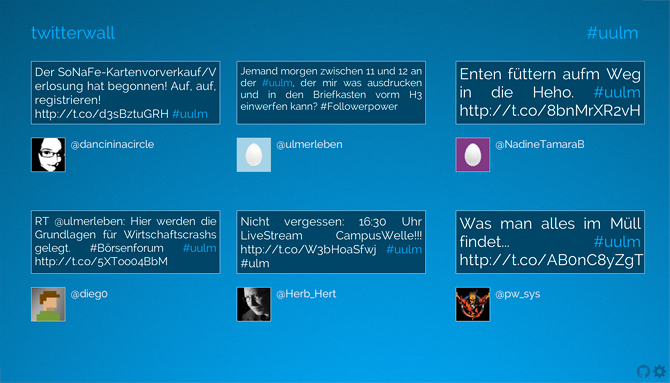
I have written a simple Twitterwall — a website which tracks tweets for a certain term. You can leave the website open and it will constantly show new tweets on the term you defined. This has proven to be quite a nice feature for events like BarCamps or other conferences. Setting up a beamer and displaying the Twitterwall in fullscreen is quite a nice feature for visitors who want to get a feeling for the conference mood or check on news.
Credit for the extrinisic motivation goes to Falco, who used the wall at the DEM 2013 and threatened to fork the project, if I wasn’t working on it. He also submitted a pull request for quite a nasty little bug. Last weekend we also used the wall at the OpenCityCamp. This brought up some issues, but I think I eventually figured them all out. The future will hold the answers.
However, the project is still in an early stage and quite simple in its functionalities. So far there is no possibility to track users/locations or show images, though I plan to add this over time. I have released the project under a free license on GitHub and as a package via npm (npm install twitterwall).
You can easily set up your own instance (further details in the readme) or you can use the public instance I have set up on http://twitterwall.creal.de.
Perfection is achieved, not when there is nothing more to add, but when there is nothing left to take away.
—Antoine de Saint-Exupéry
Simplicity is beautiful. Simplicity is pure. Simplicity is what we should aim for. Instead modern user interfaces, modern design, is overloaded. Creeping featurism: constantly adding features as a way to satisfy the need of any possible, thinkable customer that one might ever encounter. While searching for the perfect solution we eventually end up with a mess. We no longer have an interface that aims to solve a specific problem, but instead an interface that aims to solve everybody’s problems.
In a lot of ways this reminds me of the Unix philosophy, where basically the exact same problem is found within software engineering.
As an effort to improve the usability of some websites, which I often use, I started to build a loose collection of templates for the Privoxy web proxy. Basically the templates simplify the layout of the websites. I never add stuff. All I do is throw elements away.
To me, the interfaces look much more aesthetically pleasing and the websites are a lot easier to use. Unnecessary elements don’t take up all the space, don’t aim to catch the attention, don’t distract from what’s important. But make up your own opinion. On the left you see the unfiltered websites, on the right you see the websites after filtered through an AdBlock browser addon and the template collection.
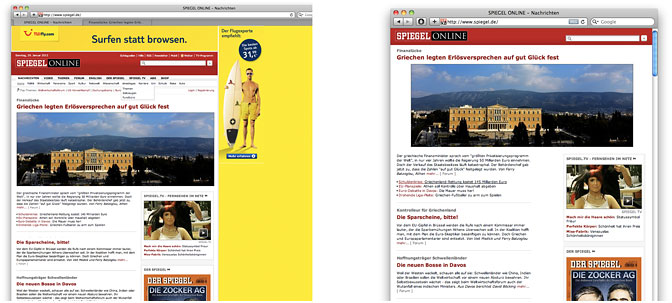
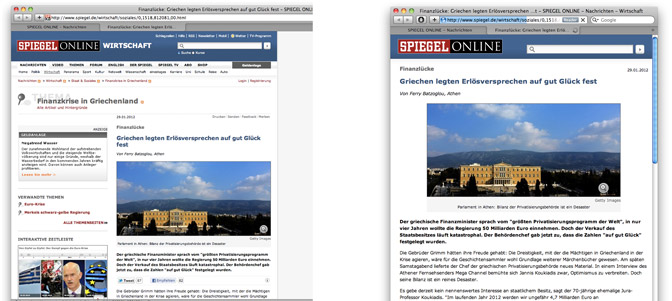
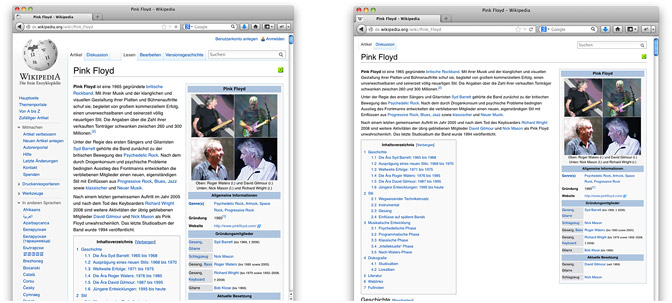
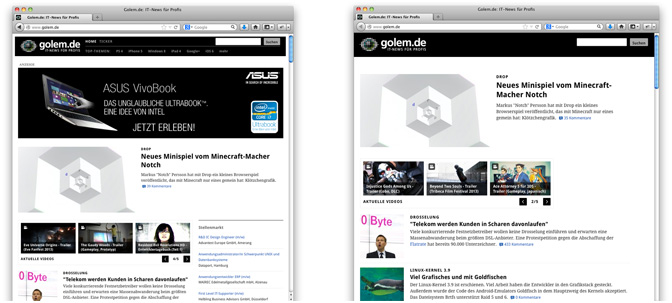
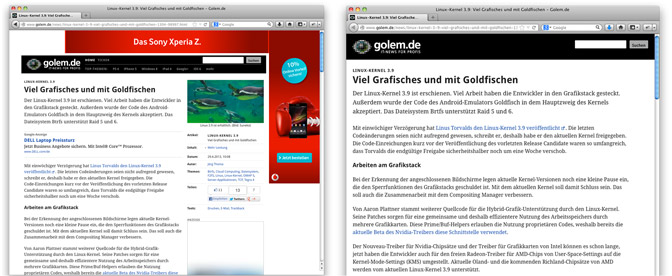
I have published the project under a free license (MIT) to GitHub. Follow the Readme there to get stuff up and running. Please note: the project is in an early stage and each CSS change on the websites might affect the templates, thus you should not be surprised if some things might not look as expected. I plan to add various other sites to the project over time.
Update: I have created a tumblr where I will publish screenshots of the latest simplified websites: minimalistic-web.tumblr.com

I spent the last few days in Bonn at the Informatiktage 2013. The event was quite nice and I got the opportunity to meet some interesting people. I attended a two-day workshop by a big tool manufacturers IT manager. The workshop was about scalability and shifting some non-crititcal components into “the cloud”. Though I am quite sceptical about the cloud-thingy, the workshop held quite some insights for me. The thing that stuck most with me was their strict implementation of the design principle “design for failure and nothing will fail“.
As part of the event a three-page paper/summarization of my bachelor thesis was published within the proceedings (first time something of me got published — yay!) and I held a poster session (the poster is linked below). For me, the exchange with other students/activists/hackers is very important. Often just simple thoughts or hints on technologies I didn’t know about, inspire new ideas and projects. During the last 2-3 year I have attended a lot of meetups, BarCamps and other events and I took something from each of them.

January and February have been very productive. I am having a good run right now. My sewing skills are getting better: though I am still struggling with sewing exact linear lines, I can definitely see my own progress. So far I have sewed various things: pouches with zippers/clips, a camera lense bag, a shopping bag, a bag for lock-picking tools etc.. I needed about seven pouch iterations before I finally got it right. I actually think I made every possible mistake you can make, from making the pouch way to small to forgetting to insert the zipper, to sewing the wrong pieces together, etc.. Also I took part in a very basic course on sewing a T-Shirt. I am very satisfied with the result and also very shocked by the amount of work it takes to produce a tee (~7 hours in my case). Even if you factor in automizing a large part of the process and a very skilled sewer — how much wage is there possible for people producing a 5,99 € tee?
Further stuff I have done in the DIY direction include building terrariums. For terrariums the idea is very simple and you can find a lot of different tutorials and ideas online (here or here for example). Basically you take a glass, put some stones in them (you need those so the water does not collect and foul at the bottom). Then you put a small layer of active chalk on top of the stones. This layer is used to prevent fouling etc.. On top you put a layer of soil, then some plants, then more soil and then e.g. some moss. Et voilà!
In February matou and I spent another day at a school as part of the “Chaos macht Schule” program. We adapted our presentation to include more practical tips on how to use the so called “new medias” (who are not really new). It is quite astonishing that kids within the age 14-15 use the Internet/Smartphones/PCs practically every day but know very little about what they are actually using. As a consequence there is an extreme lack in competence of using those technologies in the way they intend to do. Each time we visit a school we are told about cyber-mobbing incidents were the bullies were basically completely unaware of the publicity of their posts. The teachers reported that when they explain this to the kids they often times regret their actions heavily.
On the technological site, the lacking technical education shows for example when we demonstrate how easy it is to fake a mail. We have done this several times by now and the effect is always the same: enormous surprise followed by questions. This was not at all what I had anticipated! I thought this demonstration was already old like 25 years ago! The same goes for showing the Google reverse image search or internet archives like e.g. the waybackmachine. Often times the pupils have heard the phrase “The Internet never forgets.”, but from my impression this is only a phrase until we demonstrate how easy it is to get the state of e.g. a public forum from two months ago, with all the “deleted” posts. Even though we are usually invited to speak on the media-competence/privacy topic, we try to not only warn about technologies but rather also motivate to use technologies in a creative way.
On another note, I have participated in some contests. I got the second place at a logo contest of an institute at university, as a prize I have been getting some money on my studentcard from which I have been feeding off for a week or so :-).
Also I have contributed to a local T-shirt contest by a clothing store. You can see my submission below. I was given the second place here as well, which in this case meant a nice package of clothing stuff. I love participating in contests and challenges. Most of the times I don’t really care about the prizes and am much rather interested in the challenge.











